2.0 LSJ Engine: How to tune 60lb injectors - 56k = ZZzzzzz...
#1
Senior Member
Thread Starter
Join Date: 05-02-07
Location: San Jose, CA
Posts: 1,061
Likes: 0
Received 0 Likes
on
0 Posts
So after 42,363,956 pms, here it is. I was unsure as to whether to put this here or in the tuning section, but the tuning section has one already that has been muddled with learning and questions, etc. I wanted to get all of the info on the front post to make it easier. The mods can (and I am sure will) move this if needed.
First off, I need to thank everyone who helped me to learn this stuff, not the least of whom was Asphalt Assault, who started the whole trend and taught me a bunch. He started the above mentioned thread.
***Disclaimer - I am in no way responsible for anything that you do to your car as a direct or indirect result of anything I say or post! There is an inherent risk, any time that you make any changes to a car's computer.***
So here we go:
First of all, forget about all of the advertised stats for the Siemens 60lb injectors. They actually flow at somewhere around 63-65lb/hr at 43.5 psi with a factory tolerance of about 6%. It is VERY important to get your injectors flow matched and to know what the actual flow rate is. The ones I got from NewEra came with a sheet telling me the numbers, and they were flowed at 63.4lb/hr on average. I open up my "LSJ Injectors" spreadsheet and put in the appropriate numbers. This file can be found by searching the HPT forums. I then create a new worksheet and paste the numbers from the LSJ Injectors spreadsheet here. I then create a formula to divide these numbers by 1.3. It should look like this:
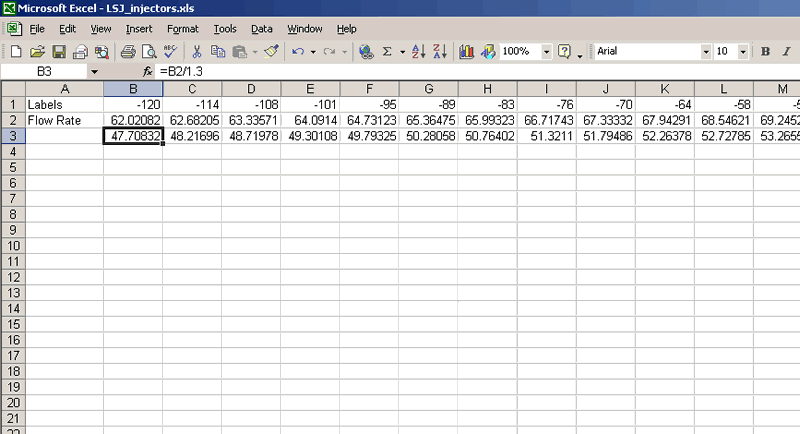
Post those numbers to your IFR table:
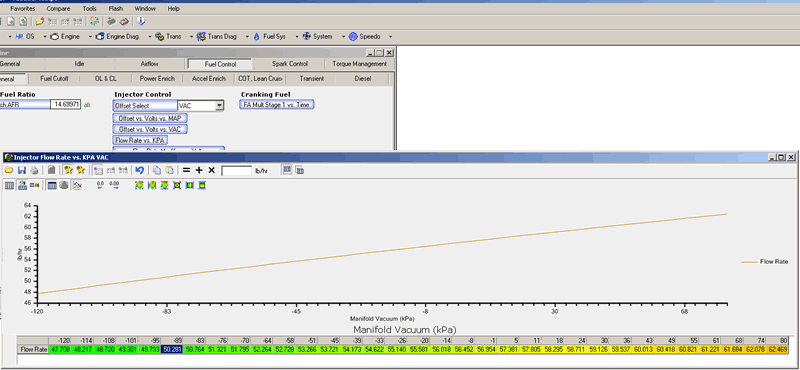
Now you go to your modifier table and enter 1.3 for all values.
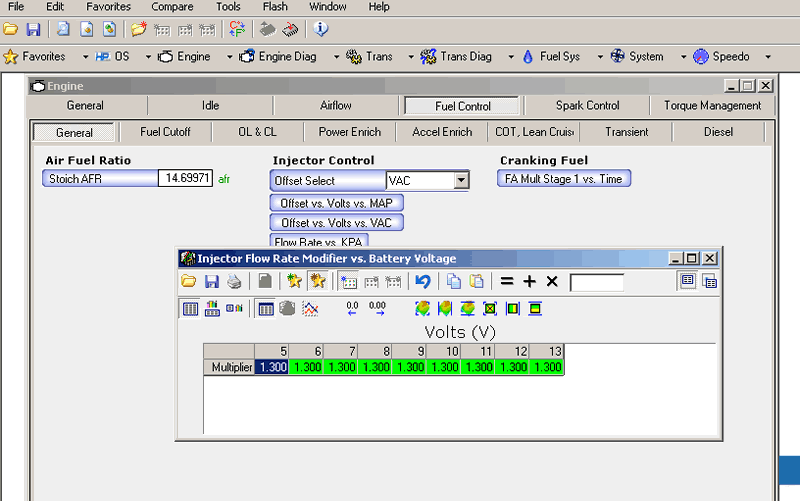
Now, know that there is some controversy over whether this actually works. The results have shown me and others that it does. It is not as exact as having an injector table that doesn't have to use the modifier, but it is FAR better than maxing out 2/3 of your table at 63.5. I am in the process of coming up with other ways to get around these little limit, but for now, this works.
Okay, IFR is set. Next are the offsets. You can actually tune the offsets, but to do it correctly requires a LOT of work. You do it by tuning your MAF at the offsets that you have, then introduce a modifier. Cot is a good one. You can also try other ways, but the purpose is to get your computer to do math based on your PWs. If the changes go rich, your offsets are too high, if go lean, they are too low. Adjust the offsets, retune your MAF and do it again. An easier way is to get them from someone who actually knows them. Every injector is a tad different, but the offsets are pretty close. These are the correct offsets:
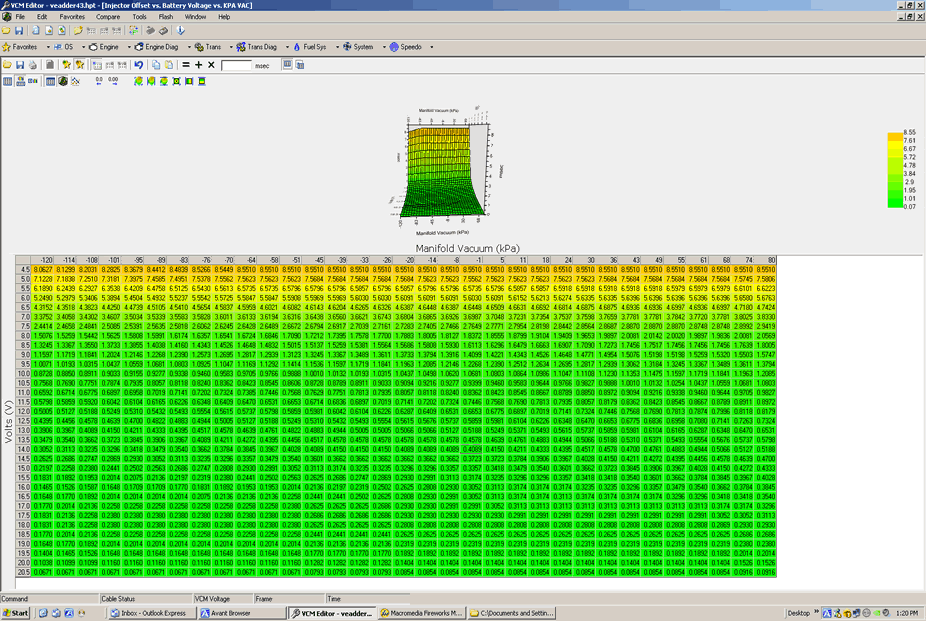
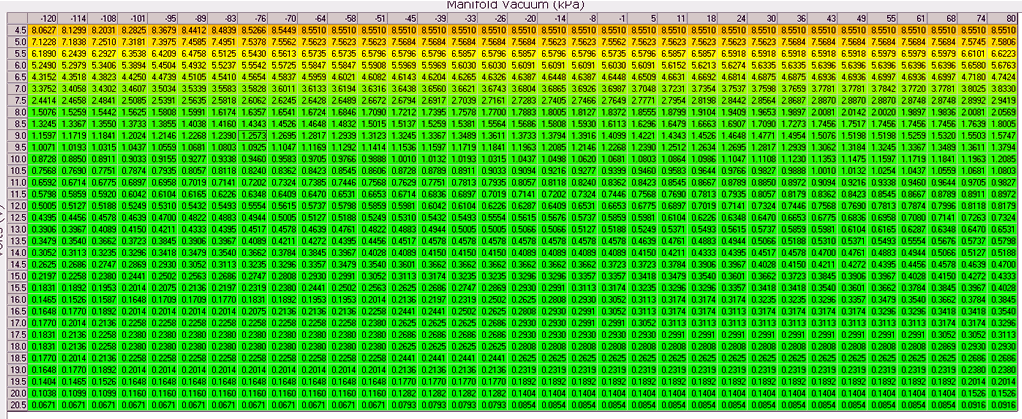
Now is the fun part. The adder table. This is where most people completely lose it. It is simple, but incredibly hard to get perfect. The reason is because these injectors just cannot flow properly in the low pulse width areas that we need them to. A return fuel system really helps here, but that is a different how to completely.
I start by entering .05 in the 1.000 msec cell of the adder and set the 0ms cell to somewhere above .6. Then interpolate. Set your short pulse limit to 1 and your min PW to .1:
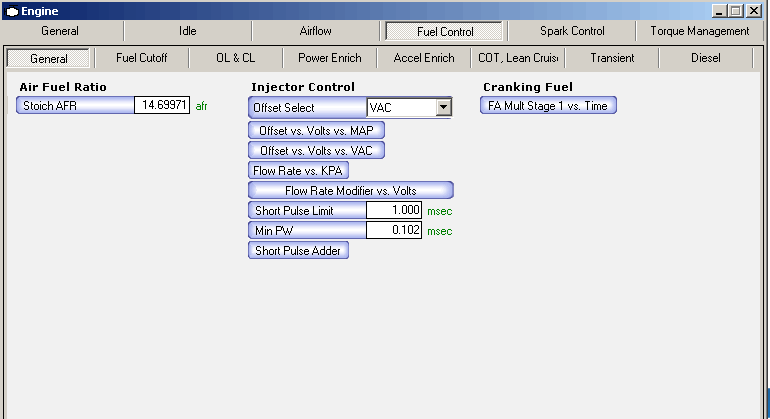
The short pulse limit tells your computer when to look at the adder table, so if you need to adjust the 1.125 cell a bit, change your short pulse limit to 1.125.
Now, remember your excel spreadsheet? Add a new worksheet. Go to your adder table, highlight it and copy with labels. Paste to your new worksheet. Next, enter a formula to add the 2 together. Should look like this:
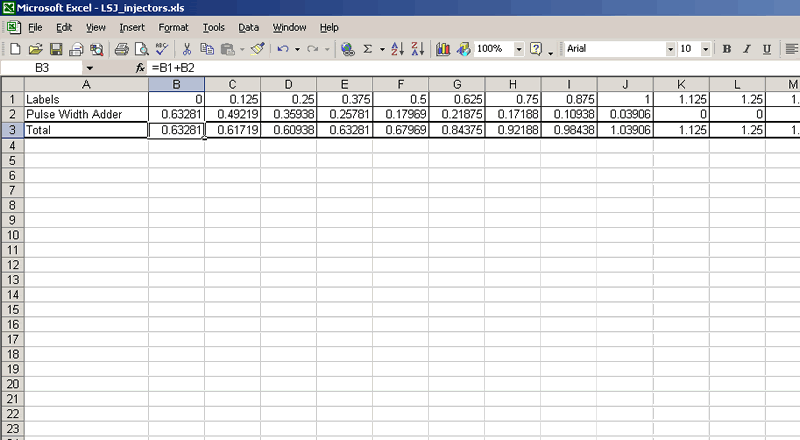
Now, set up your AFR error histogram like this:
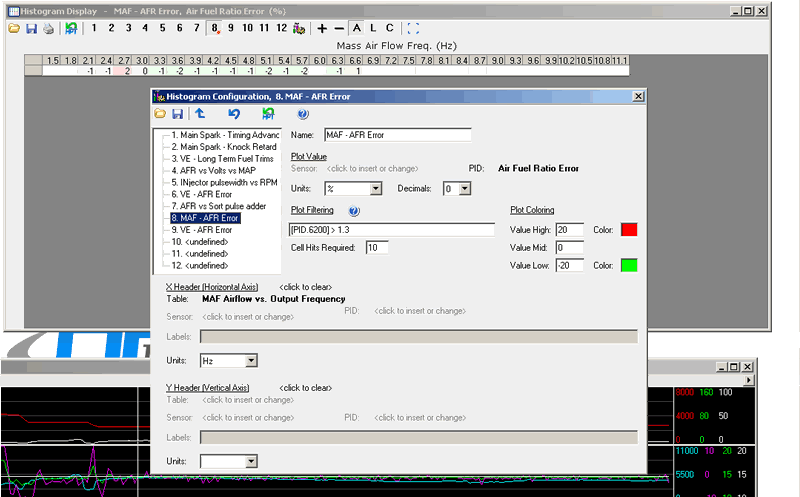
This will filter out any data received when the PW is below your filter limit - in this case 1.3ms. It will only show data from 1.3ms up. Now, at this point, I recommend you set up a MAF trim histo and run in CL for a bit, to get your AFRs close. You just made some pretty drastic changes and I want your car to actually start. Once you get fairly close with the trims on, switch to open loop and tune your MAF using AFR error. You should now have a perfect MAF from 1.3 ms on up, which will include everything from the 2400 hz cell of your MAF table to RL. Now, the PW is calculated by the computer figuring out how much fuel is needed + the offset needed to deliver that amount of fuel. Because the offsets change with manvac, you will command a different PW at 2400 during accell than you will at 2400 during decel. This is going to help you. Create another histogram.:
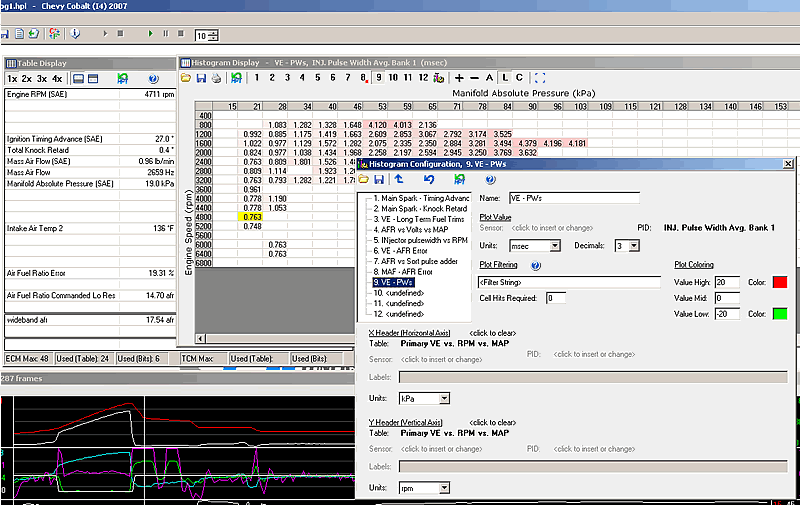
This will show your PWs. What I do here is, I will go through my graph and see where I am running really lean or really rich. Not in spikes, but for durations. Set the view mode to "L" for last value. As you can see from the picture above, I am really lean at .763ms. I see the lean spot on the graph, my PW histo says .763, and by following that whole "lean" spot on my graph, the PW is a steady .763. This is good info. I look at my table and see that I am at 2659hz. Well, I know that the 2400 and 2700 hz cells of my maf are tuned (above 1.3ms) so this is not a MAF error. It has to be a fueling error. I go through and make some notes at which PWs under 1.3ms gives me what errors, and make sure there are definite trends here. Forget flukes, look for consistent data. Now gather your information and go to your excel spreadsheet to see where the changes need to be made. To use the example above: I know I have a lean fueling error at .763ms. By looking at my excel spreadsheet, I see that my total at .5ms is actually .679 and my total at .625 is actually .843. Here's where it gets tough, because I need to figure out which one to change. By further studying the data, I see that everything in the low.7xxms range is lean and the low to mid .8xxx is a little rich. The lean is far more pronounced than the rich, so I bump the .5ms cell of the adder to remove the lean errors. I'll leave the rich error alone for now. You'll find that your injectors hate PWs in the low .9s. This is an example of a 60s adder table.
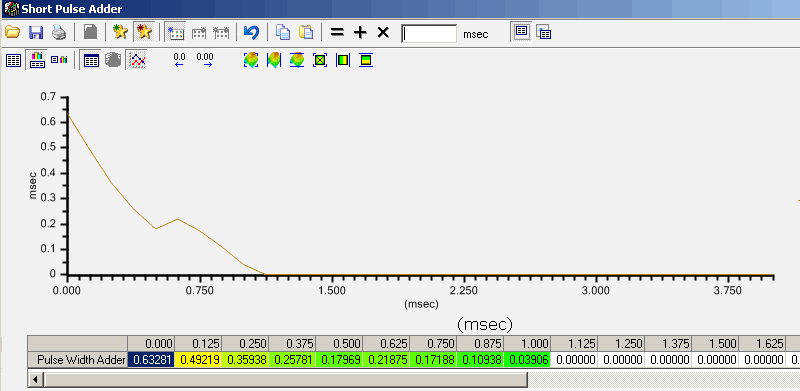
You may find you are having some issues with the lower MAF cells. One thing that I have found that helps is to zero out the cells from 4200 on up, or 5400 on up, just to see what the lower cells look like. MAF is a 3rd order polynomial, so it should be smooth. If your MAF is all full of peaks and valleys, you're doing something wrong.
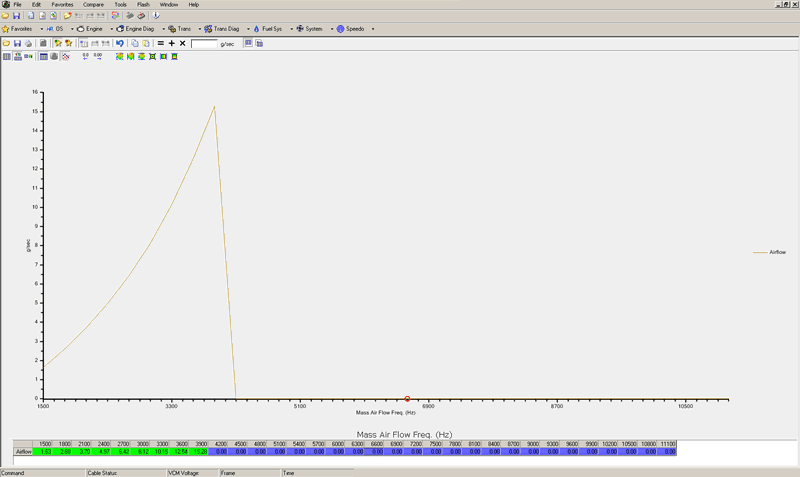
Oh, and once you are done looking at your lower MAF cells, don't forget to put it back to normal. I left half of it zeroed once and my car didn't like it much.
So are we having fun yet, or what?
First off, I need to thank everyone who helped me to learn this stuff, not the least of whom was Asphalt Assault, who started the whole trend and taught me a bunch. He started the above mentioned thread.
***Disclaimer - I am in no way responsible for anything that you do to your car as a direct or indirect result of anything I say or post! There is an inherent risk, any time that you make any changes to a car's computer.***
So here we go:
First of all, forget about all of the advertised stats for the Siemens 60lb injectors. They actually flow at somewhere around 63-65lb/hr at 43.5 psi with a factory tolerance of about 6%. It is VERY important to get your injectors flow matched and to know what the actual flow rate is. The ones I got from NewEra came with a sheet telling me the numbers, and they were flowed at 63.4lb/hr on average. I open up my "LSJ Injectors" spreadsheet and put in the appropriate numbers. This file can be found by searching the HPT forums. I then create a new worksheet and paste the numbers from the LSJ Injectors spreadsheet here. I then create a formula to divide these numbers by 1.3. It should look like this:

Post those numbers to your IFR table:

Now you go to your modifier table and enter 1.3 for all values.

Now, know that there is some controversy over whether this actually works. The results have shown me and others that it does. It is not as exact as having an injector table that doesn't have to use the modifier, but it is FAR better than maxing out 2/3 of your table at 63.5. I am in the process of coming up with other ways to get around these little limit, but for now, this works.
Okay, IFR is set. Next are the offsets. You can actually tune the offsets, but to do it correctly requires a LOT of work. You do it by tuning your MAF at the offsets that you have, then introduce a modifier. Cot is a good one. You can also try other ways, but the purpose is to get your computer to do math based on your PWs. If the changes go rich, your offsets are too high, if go lean, they are too low. Adjust the offsets, retune your MAF and do it again. An easier way is to get them from someone who actually knows them. Every injector is a tad different, but the offsets are pretty close. These are the correct offsets:


Now is the fun part. The adder table. This is where most people completely lose it. It is simple, but incredibly hard to get perfect. The reason is because these injectors just cannot flow properly in the low pulse width areas that we need them to. A return fuel system really helps here, but that is a different how to completely.

I start by entering .05 in the 1.000 msec cell of the adder and set the 0ms cell to somewhere above .6. Then interpolate. Set your short pulse limit to 1 and your min PW to .1:

The short pulse limit tells your computer when to look at the adder table, so if you need to adjust the 1.125 cell a bit, change your short pulse limit to 1.125.
Now, remember your excel spreadsheet? Add a new worksheet. Go to your adder table, highlight it and copy with labels. Paste to your new worksheet. Next, enter a formula to add the 2 together. Should look like this:

Now, set up your AFR error histogram like this:

This will filter out any data received when the PW is below your filter limit - in this case 1.3ms. It will only show data from 1.3ms up. Now, at this point, I recommend you set up a MAF trim histo and run in CL for a bit, to get your AFRs close. You just made some pretty drastic changes and I want your car to actually start. Once you get fairly close with the trims on, switch to open loop and tune your MAF using AFR error. You should now have a perfect MAF from 1.3 ms on up, which will include everything from the 2400 hz cell of your MAF table to RL. Now, the PW is calculated by the computer figuring out how much fuel is needed + the offset needed to deliver that amount of fuel. Because the offsets change with manvac, you will command a different PW at 2400 during accell than you will at 2400 during decel. This is going to help you. Create another histogram.:

This will show your PWs. What I do here is, I will go through my graph and see where I am running really lean or really rich. Not in spikes, but for durations. Set the view mode to "L" for last value. As you can see from the picture above, I am really lean at .763ms. I see the lean spot on the graph, my PW histo says .763, and by following that whole "lean" spot on my graph, the PW is a steady .763. This is good info. I look at my table and see that I am at 2659hz. Well, I know that the 2400 and 2700 hz cells of my maf are tuned (above 1.3ms) so this is not a MAF error. It has to be a fueling error. I go through and make some notes at which PWs under 1.3ms gives me what errors, and make sure there are definite trends here. Forget flukes, look for consistent data. Now gather your information and go to your excel spreadsheet to see where the changes need to be made. To use the example above: I know I have a lean fueling error at .763ms. By looking at my excel spreadsheet, I see that my total at .5ms is actually .679 and my total at .625 is actually .843. Here's where it gets tough, because I need to figure out which one to change. By further studying the data, I see that everything in the low.7xxms range is lean and the low to mid .8xxx is a little rich. The lean is far more pronounced than the rich, so I bump the .5ms cell of the adder to remove the lean errors. I'll leave the rich error alone for now. You'll find that your injectors hate PWs in the low .9s. This is an example of a 60s adder table.

You may find you are having some issues with the lower MAF cells. One thing that I have found that helps is to zero out the cells from 4200 on up, or 5400 on up, just to see what the lower cells look like. MAF is a 3rd order polynomial, so it should be smooth. If your MAF is all full of peaks and valleys, you're doing something wrong.

Oh, and once you are done looking at your lower MAF cells, don't forget to put it back to normal. I left half of it zeroed once and my car didn't like it much.
So are we having fun yet, or what?

Last edited by TommyP; 10-03-2012 at 01:10 PM.
#2
Senior Member
Thread Starter
Join Date: 05-02-07
Location: San Jose, CA
Posts: 1,061
Likes: 0
Received 0 Likes
on
0 Posts
Injectors part 2 - How to convert to return style fueling!
Okay, now for part 2 of our injector tuning how-to. This one involves tuning for a return style conversion. I am not going to go into detail about the install itself, as that is already covered in other threads. This is strictly meant to address the changes that need to be made to tune for them.
By far, the easiest way to go about this is to first make sure you have good injector tables to start with. It is much easier to make the proper changes to tables that are correct to begin with. If you need help with that part of it, read up^^
So the first step is to decide what you want your base pressure to be. That is the rail pressure with the car running and the vacuum line to the regulator disconnected. By messing with the LSJ injector spreadsheet, I found that my injectors have a static flow of 63.5lbs.hr at a rail pressure of 42psi. I decided to go with that (since that is the highest our ECM supports without using a modifier) and set my regulator at 42psi base pressure. Since I now have a return system with a regulator that references manifold vacuum, the effective pressure will be the same across the board. That means my IFR table will be set at 63.5 across the table like this:
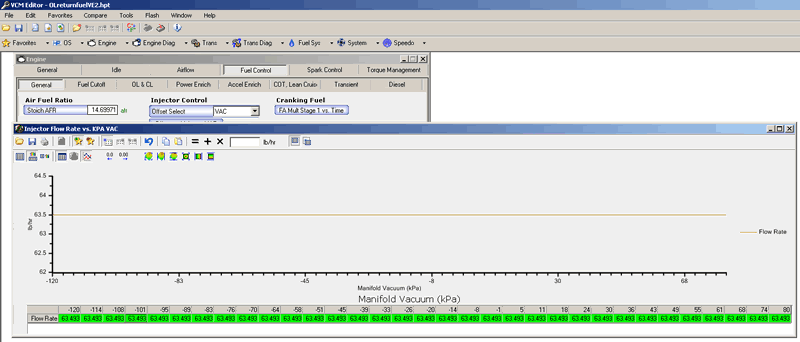
Now set your modifier vs volts to 1 across the board.
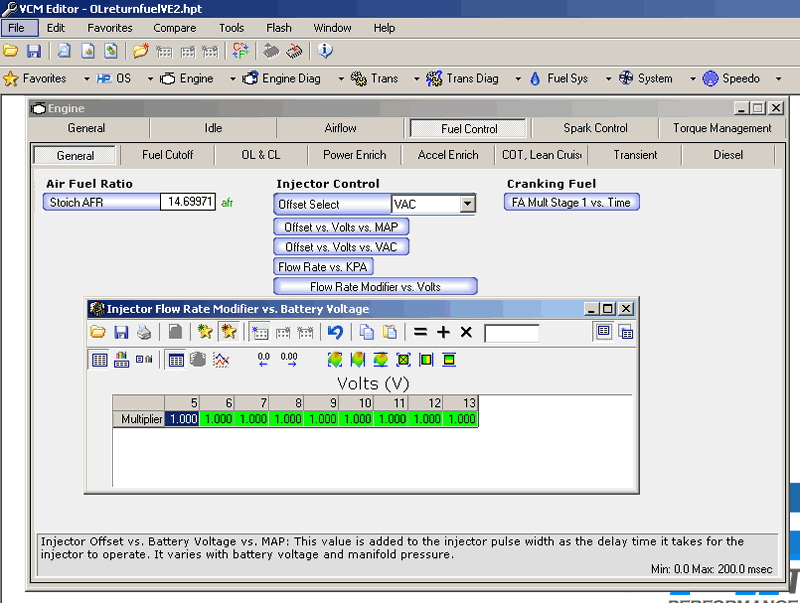
Next I need to do some math. My offset table is correct for a fuel pressure of 58psi, with an effective pressure that goes up when the car is in vac and goes down when it is in boost like our cars do stock. Since my car doesn't do that anymore with a return system, I need to change this table. Since I set my regulator at 42psi and my offset table is for 58 psi, I subtract and come up with 16. I next go to the converter in HPTuners and convert that to kPa.

So I am running a base pressure that is about 110kPa less than stock. Remember that vacuum raises effective pressure and boost lowers it. I go to my offset vs volts vs vac table. I need to effectively lower my pressure by 110kPa. I choose the -108kPa vac column and I copy
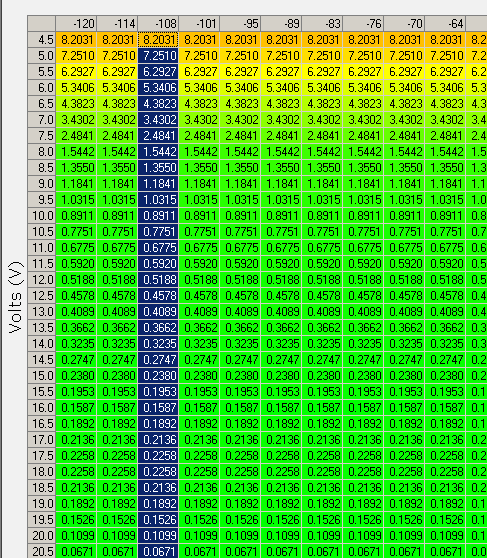
And paste to all of the columns, so that they are the same all the way across.

Keep in mind that I decided to go with a fairly low base pressure, so that I could stay within the limits of my IFR table and to give myself a higher pulsewidth at idle, making it much much easier to tune these things. If you decide to run a higher pressure that puts you above 63.5lbs/hr you will need to use a modifier above "1" to get the correct IFR.
That’s it! Now go tune your MAF and adders…
By far, the easiest way to go about this is to first make sure you have good injector tables to start with. It is much easier to make the proper changes to tables that are correct to begin with. If you need help with that part of it, read up^^

So the first step is to decide what you want your base pressure to be. That is the rail pressure with the car running and the vacuum line to the regulator disconnected. By messing with the LSJ injector spreadsheet, I found that my injectors have a static flow of 63.5lbs.hr at a rail pressure of 42psi. I decided to go with that (since that is the highest our ECM supports without using a modifier) and set my regulator at 42psi base pressure. Since I now have a return system with a regulator that references manifold vacuum, the effective pressure will be the same across the board. That means my IFR table will be set at 63.5 across the table like this:

Now set your modifier vs volts to 1 across the board.

Next I need to do some math. My offset table is correct for a fuel pressure of 58psi, with an effective pressure that goes up when the car is in vac and goes down when it is in boost like our cars do stock. Since my car doesn't do that anymore with a return system, I need to change this table. Since I set my regulator at 42psi and my offset table is for 58 psi, I subtract and come up with 16. I next go to the converter in HPTuners and convert that to kPa.

So I am running a base pressure that is about 110kPa less than stock. Remember that vacuum raises effective pressure and boost lowers it. I go to my offset vs volts vs vac table. I need to effectively lower my pressure by 110kPa. I choose the -108kPa vac column and I copy

And paste to all of the columns, so that they are the same all the way across.

Keep in mind that I decided to go with a fairly low base pressure, so that I could stay within the limits of my IFR table and to give myself a higher pulsewidth at idle, making it much much easier to tune these things. If you decide to run a higher pressure that puts you above 63.5lbs/hr you will need to use a modifier above "1" to get the correct IFR.
That’s it! Now go tune your MAF and adders…

Last edited by SJSchafer; 05-14-2008 at 12:07 AM.
#4
Senior Member
Join Date: 03-03-06
Location: Pittsburgh, PA
Posts: 4,958
Likes: 0
Received 0 Likes
on
0 Posts
Kinda curious how everyone else is tuning the return style system. I installed mine less than a week ago and have been toying around with it a bit.
#6
Senior Member
Thread Starter
Join Date: 05-02-07
Location: San Jose, CA
Posts: 1,061
Likes: 0
Received 0 Likes
on
0 Posts

What I am doing is first deciding on a base pressure, depending what I want to accomplish. Take the difference between my new base pressure and 58 psi and convert it to kPa. That lets me know which column of my offset table (and IFR) to use.
#9
Senior Member
Thread Starter
Join Date: 05-02-07
Location: San Jose, CA
Posts: 1,061
Likes: 0
Received 0 Likes
on
0 Posts
Hey Witt, I tried to PM you, but I can't for some reason. You still have my email?
Last edited by SJSchafer; 05-13-2008 at 05:59 PM. Reason: Automerged Doublepost
#11
Senior Member
Join Date: 03-03-06
Location: Pittsburgh, PA
Posts: 4,958
Likes: 0
Received 0 Likes
on
0 Posts
Damn, pretty much what I did. Set 43.5 psi base which might not be enough actually, but used my values in the 130kpa table I think? and copied them to all the other columns. Its basically a table of static values horizontally with changes only taking place by voltage. I also swapped to a MAP axis from the vacuum one.
#13
Senior Member
Thread Starter
Join Date: 05-02-07
Location: San Jose, CA
Posts: 1,061
Likes: 0
Received 0 Likes
on
0 Posts
Damn, pretty much what I did. Set 43.5 psi base which might not be enough actually, but used my calues in the 130kpa table I think? and copied them to all the other columns. Its basically a table of static values horizontally with changes only taking place by voltage. I also swapped to a MAP axis from the vacuum one.
#15
Senior Member
iTrader: (1)
Join Date: 01-23-06
Location: on here
Posts: 10,731
Likes: 0
Received 0 Likes
on
0 Posts
Damn, pretty much what I did. Set 43.5 psi base which might not be enough actually, but used my values in the 130kpa table I think? and copied them to all the other columns. Its basically a table of static values horizontally with changes only taking place by voltage. I also swapped to a MAP axis from the vacuum one.
#16
Senior Member
Join Date: 03-03-06
Location: Pittsburgh, PA
Posts: 4,958
Likes: 0
Received 0 Likes
on
0 Posts
For you 43.5 might be a bit low, but with 60s it will at least keep you just under the 63.5 cap on the IFRs (depending on your actual flow rates). I actually had to set my new ones to flow 42psi base. At 43.5 though, the difference is actually 14.5psi (100kPa). That would be the -101kPa vac row of the offset chart above (0.32959 at 14v).
Changed the table used to the MAP one so thats why I'm using the 120 or 130 row.
/threadjack
#19
Senior Member
Thread Starter
Join Date: 05-02-07
Location: San Jose, CA
Posts: 1,061
Likes: 0
Received 0 Likes
on
0 Posts

Yea, if you need to actually do some tuning on your offsets, the MAP table is the only way to go. The good thing about a return system is that it doesn't really matter, since your flatlined vs map anyway.
#20
Senior Member
Join Date: 03-03-06
Location: Pittsburgh, PA
Posts: 4,958
Likes: 0
Received 0 Likes
on
0 Posts
#22
Senior Member
Join Date: 09-05-07
Location: Sasebo Japan
Posts: 10,662
Likes: 0
Received 0 Likes
on
0 Posts
#23
Senior Member
Join Date: 03-03-06
Location: Pittsburgh, PA
Posts: 4,958
Likes: 0
Received 0 Likes
on
0 Posts
That's right, I forgot you were using those fancy disk injectors. 
Yea, if you need to actually do some tuning on your offsets, the MAP table is the only way to go. The good thing about a return system is that it doesn't really matter, since your flatlined vs map anyway.

Yea, if you need to actually do some tuning on your offsets, the MAP table is the only way to go. The good thing about a return system is that it doesn't really matter, since your flatlined vs map anyway.

#24
Senior Member
Thread Starter
Join Date: 05-02-07
Location: San Jose, CA
Posts: 1,061
Likes: 0
Received 0 Likes
on
0 Posts


